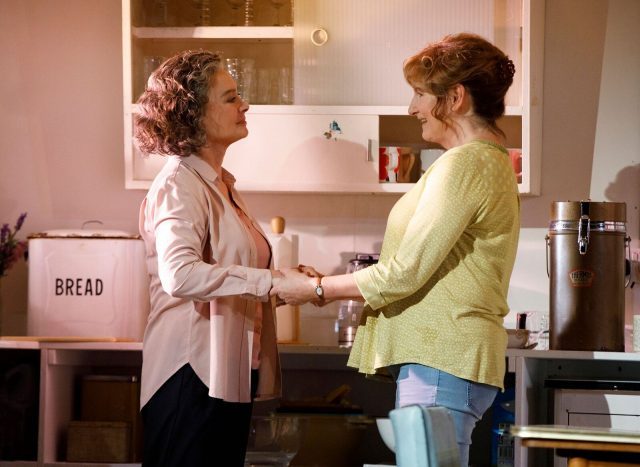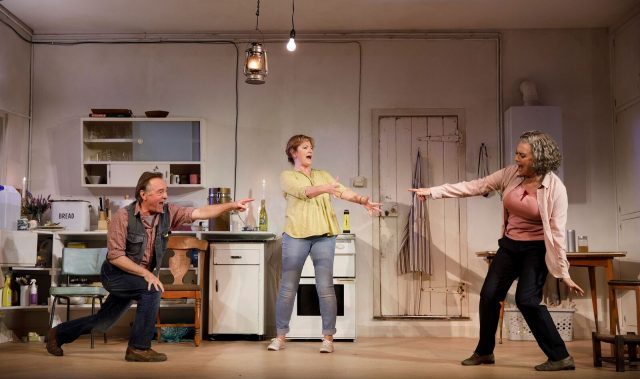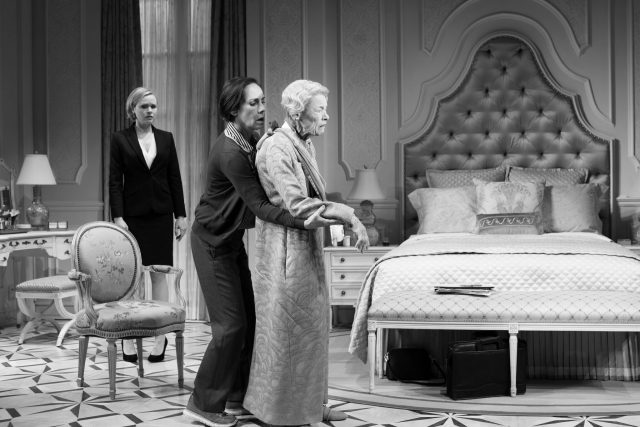
Laurie Metcalf helps Glenda Jackson to her favorite chair as Alison Pill looks on in Three Tall Women (photo © Brigitte Lacombe)
Golden Theatre
252 West 45th St. between Broadway & Eighth Ave.
Tuesday – Sunday through June 24, $47 – $159
threetallwomenbroadway.com
Edward Albee’s 1991 Pulitzer Prize–winning play, Three Tall Women, is finally making its Broadway debut, in an elegant, exquisitely rendered production directed by Joe Mantello at the Golden Theatre, featuring American actress Laurie Metcalf, Canadian actress Alison Pill, and British legend Glenda Jackson. The two-act intermissionless play, an ingenious depiction of aging, among other things, takes place in the 1990s in the lush bedroom of a sneering, wealthy widow identified in the program as A (Jackson), who is in her early nineties. She lives with her wisecracking, pessimistic caretaker, B (Metcalf), who is fifty-two. They have been joined by the deadly serious C (Pill), a twenty-six-year-old sharply dressed lawyer who needs A to sign some forms she’s been ignoring. Each woman represents a different class and generation, youth, middle age, and old age, each with different values, desires, and expectations, but as B likes to point out, everyone is on their way toward death. “Start in young,” she says, referring to children. “Make ’em aware that they’ve got only a little time. Make ’em aware that they’re dying from the minute they’re alive.” Amid visits to the bathroom, anecdotes about the past, and legal papers to be signed, the women deliver rapid comebacks with plenty of snark as they consider the state of their lives. But then a paradigm shift occurs, and in the second act there is a slight but key change in the set and in the characters, who are no longer quite what they were previously. Once the audience realizes what is happening, there are likely to be more than a few thrilled gasps of recognition as Albee peers ever deeper into the life of the female species, leading to an utterly breathtaking finale.
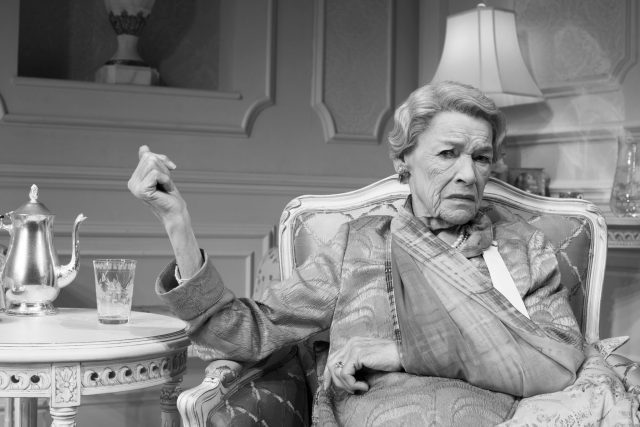
Glenda Jackson holds court in Edward Albee’s Three Tall Women at the Golden Theatre (photo © Brigitte Lacombe)
Three Tall Women was inspired by Albee’s troubled relationship with his adoptive mother. “We had managed to make each other very unhappy over the years, but I was past all that, though I think she was not,” Albee wrote in the introduction to the published 1994 edition of the play. “I harbor no ill-will toward her; it is true I did not like her much, could not abide her prejudices, her loathings, her paranoias, but I did admire her pride, her sense of self. . . . No, it was not a revenge piece I was after, and I was not interested in ‘coming to terms’ with my feelings toward her.” It is precisely for those reasons that Three Tall Women works so well. There are no heroes or villains, no black-and-white depictions of good and evil. A, B, and C all have their own strengths and weaknesses; despite the specificity of their lives, they are everywoman, experiencing the ups and downs of everyday existence, since death is the great equalizer. Few male playwrights have drafted such female characters as Albee, who also displayed that vast skill in such other works as The Lady from Dubuque; The Goat, or Who Is Sylvia?; Who’s Afraid of Virginia Woolf? and Pulitzer Prize winners A Delicate Balance and Seascape.
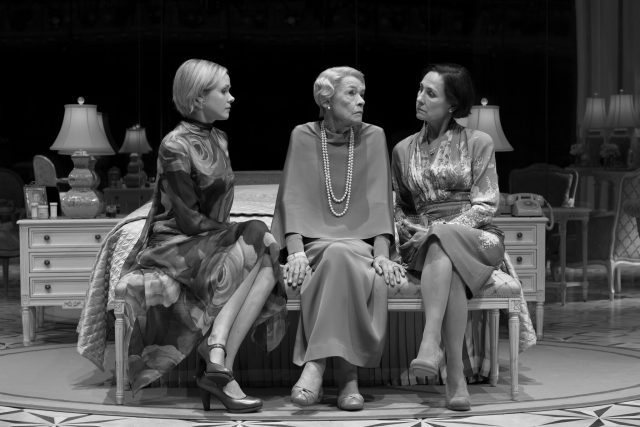
Alison Pill, Glenda Jackson, and Laurie Metcalf star in Broadway debut of Edward Albee’s Three Tall Women (photo © Brigitte Lacombe)
The eighty-one-year-old Jackson (Strange Interlude, A Touch of Class), in a tight hairstyle that is a character unto itself, is feisty and glamorous in her first Broadway role since she was nominated for a Tony in Macbeth in 1988, having left acting to pursue a career in politics, serving as an MP from 1992 to 2015; her A is a bigoted wealthy widow, mother, and former grande dame who is refusing to come to terms with the maladies that befall the elderly, no matter how rich they might be. The sixty-two-year-old Metcalf (A Doll’s House Part 2, The Other Place) gives a homey charm to the sarcastic spinster B. And the thirty-two-year-old Pill (Blackbird, The Lieutenant of Inishmore) holds her own as the practical C, who has dreams of a great future for herself despite seeing what lies ahead. (Among the other trios to have played the three women are Myra Carter, Marian Seldes, and Jordan Baker at the Vineyard in 1994 and Maggie Smith, Frances de la Tour, and Anastasia Hille in the West End that same year.) Two-time Tony winner Mantello (The Humans, Love! Valour! Compassion!) lets the three actresses strut their stuff with minimal intrusion on Miriam Buether’s opulent bedroom set, which is centered by the stately bed itself, here representing birth, sex, and, ultimately, death.
